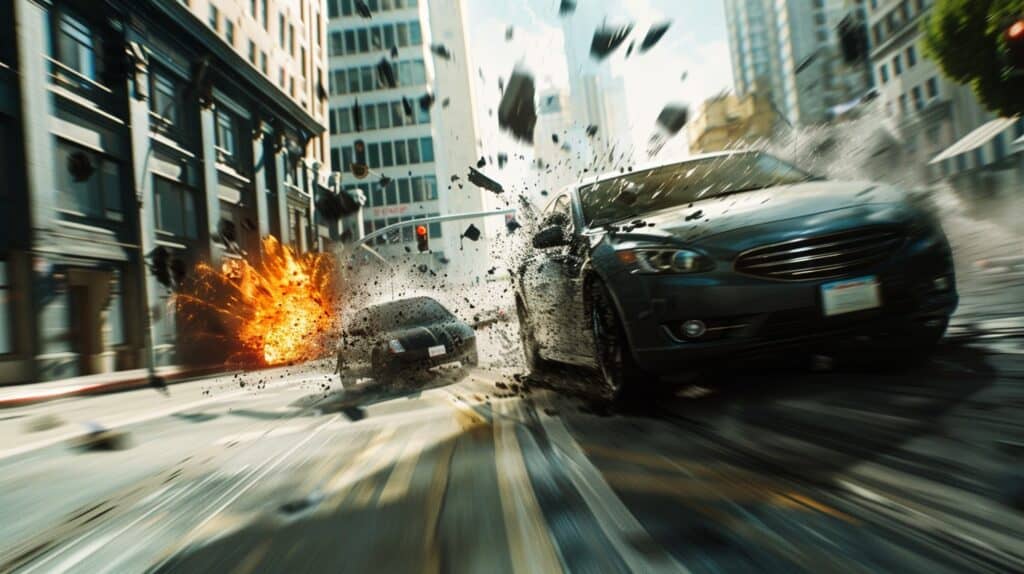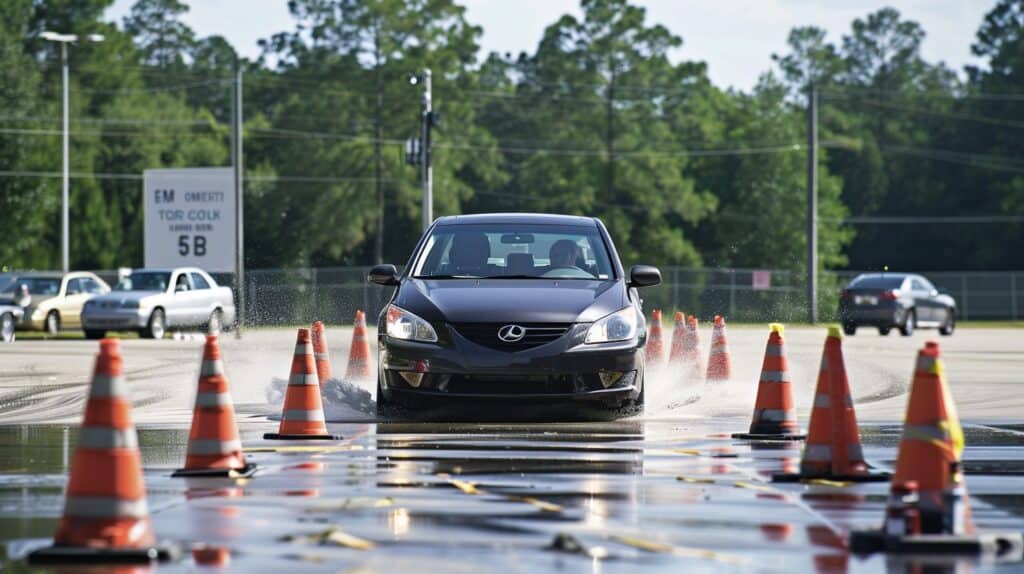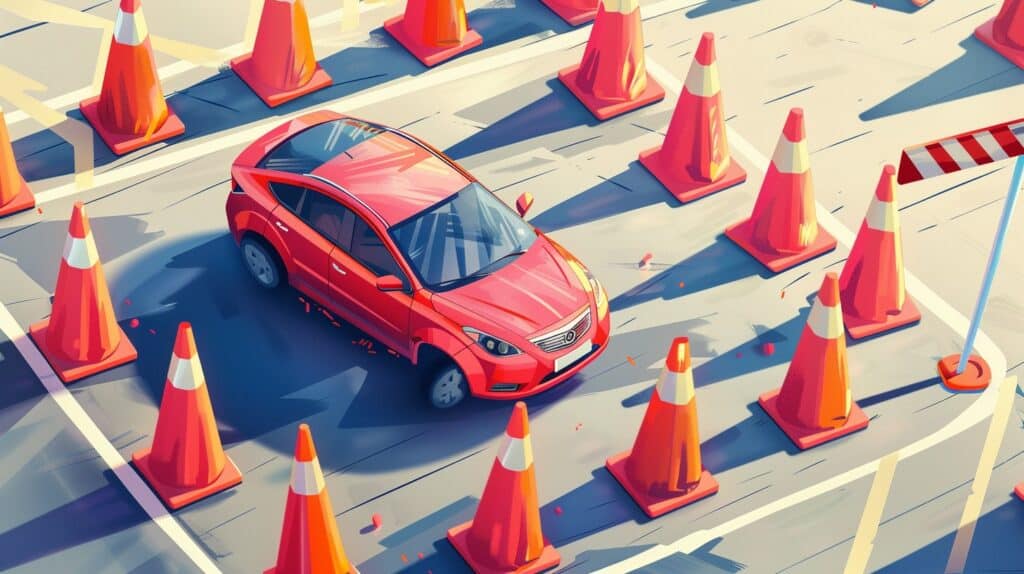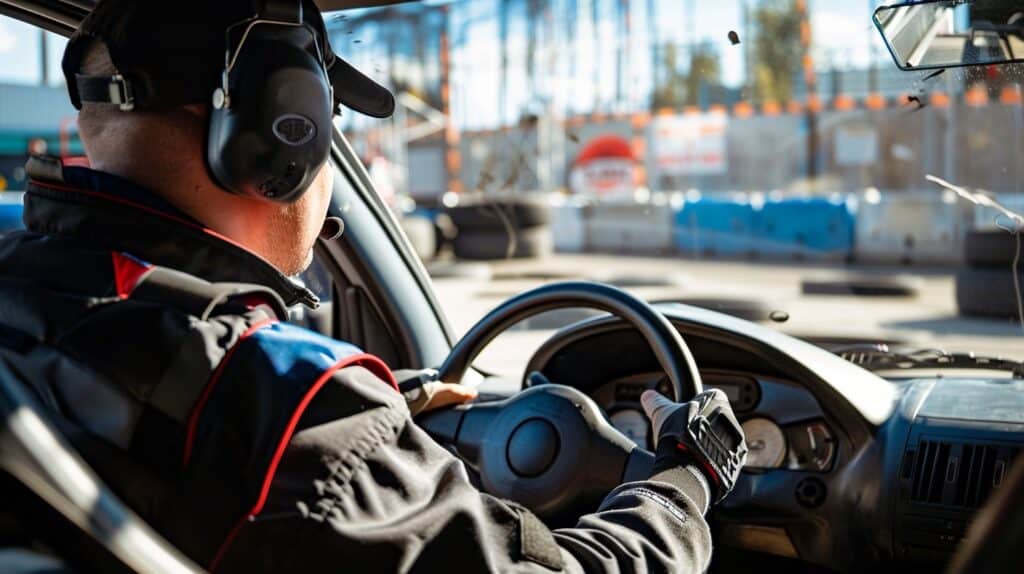Facing tough traffic can feel like a scene from a John Wick movie. Tactical driving skills are crucial for safety and efficiency on the road. This guide offers step-by-step tactics for mastering both defensive and offensive driving strategies.
Get ready to drive smarter, not harder.
Key Takeaways
Knowing your car type (FWD, RWD, AWD) helps you handle it better in different situations like turning sharply or speeding up from a stop.
Staying alert and using mirrors right can help you see dangers early and plan safe exits. It’s important to keep an eye on other drivers too.
Practice defensive driving by keeping a good spot on the road, using signals early, and staying ready for sudden changes around you.
Learning how to pass cars safely and change lanes quickly is key for moving through traffic smoothly.
Training and preparing regularly with the right vehicle improve your tactical driving skills. Upgrades like performance tires and strong brakes also help.
Table of Contents
Fundamentals of Tactical Driving

Tactical driving is all about knowing your vehicle and staying alert. Places like Ferrari Driving School in Queens, NY, teach you on both closed courses and real streets to make sure you’re ready for anything.
Exploring Vehicle Dynamics
Understanding how your car moves and reacts is key. Different cars behave differently on the road. Front-wheel drive (FWD) cars often have trouble turning sharply in corners. They don’t follow the curve like you want them to.
This is called under-steering. Rear-wheel drive (RWD) vehicles, though, are better at cornering and speeding up fast from a stop. But, if you’re not used to it, this can make the car spin out of control easily.
All-wheel drive (AWD) vehicles strike a balance between FWD and RWD cars, but still face their own challenge of under-steering if they lack an active or manual center differential system for power distribution among wheels.
In short, knowing your vehicle’s type helps greatly in handling it safely during high-speed pursuits or evasive maneuvers to avoid collisions or skidding on slippery roads. Use situational awareness along with understanding of disc brakes efficiency and collision avoidance techniques to master tactical driving in any situation.
Importance of Situational Awareness
Situational awareness is knowing what’s happening around you. It means adjusting your mirrors to see blind spots and looking for ways out if things go bad. You must choose the safest path, not just the cheapest or fastest, to avoid trouble.
Stay alert at all times; it’s your best defense on the road. Fixing blind spots with mirror adjustments lets you see dangers early. Planning exits keeps you ready for quick moves to stay safe.
Mastering situational awareness helps in defensive driving too. It means predicting other drivers’ actions before they happen. With good situational awareness, you can spot a car that might cut you off or a pedestrian stepping into traffic without looking.
The key to survival on the road is anticipation.
Now let’s talk about how to position yourself safely while driving defensively.
Mastering Defensive Driving Techniques

To keep safe, you need to nail defensive driving. It’s all about where you put your car and how you watch others.
Optimal Positioning on the Road
Driving smart means knowing where your car should be on the road. The best spot gives you visibility, control, and options to move if needed. Stay in a lane that keeps you away from too much traffic, but close enough to act fast.
Drivers must see around them—front, back, and sides. This means using mirrors right and keeping an eye out for quick changes.
For safety, position your car where it can avoid danger without sudden moves. Think about your escape routes all the time. If another driver does something unexpected or there’s debris ahead, you’ll need space to steer clear safely.
Good drivers plan their moves before they have to make them—they don’t just react. They use headlights wisely at night for better sight and signal early, so others know their intentions.
Staying alert and ready means fewer surprises on the road.
Use of Mirrors and Signals for Safety
After finding the best spot on the road, focus on mirrors and signals. These tools keep you and others safe.
- Adjust your side mirrors to cover blind spots. This lets you see cars and bikes next to you without turning your head.
- Check your rearview mirror every 5–10 seconds. This habit helps track vehicles behind you, maintaining a safe distance.
- Use turn signals at least 100 feet before turning or changing lanes. It gives other drivers time to react.
- Practice trail braking in tight turns to control speed and improve visibility.
- Tap your brake lightly a few times before slowing down. This alerts drivers behind you that you’re reducing speed.
- Look for pedestrians, especially in busy areas. Making eye contact ensures they know you’ve seen them.
- Avoid skids by steering smoothly and using signals early in bad weather.
- Practice the precision immobilization technique (PIT maneuver) safely in training, not on public roads.
- Plan escape routes using mirrors if you’re blocked or threatened by another car.
- Always signal before drifting into another lane during high-speed maneuvers, ensuring others are aware of your move.
These steps make sure you use mirrors and signals right for everyone’s safety on the road.
Predicting Other Drivers’ Actions
Predicting what other drivers will do is key to staying safe and keeping control. It’s like playing a game where you need to guess the next move of your opponent, but in this case, it can save lives.
You must watch for signs–a turn signal blinking, wheels turning toward an intersection, or someone speeding up to change lanes. These hints tell you what they might do next.
To master this skill, focus on their behavior and match it with traffic flow rules. If you see a driver weaving through traffic at a safe speed, expect them to switch lanes without warning.
Similarly, if someone approaches a stop sign too fast, they may not stop completely. Always prepare for their possible moves and adjust yours accordingly.
In tactical driving, anticipating the actions of others isn’t just smart; it’s essential.
Implementing Offensive Driving Strategies

Getting through traffic fast needs smart moves. Learn to pass other cars safely and switch lanes like a pro.
Navigating Traffic Efficiently
To cut through traffic like Jason Bourne, focus on the flow and your moves. Keep a keen eye on spaces between cars—these are your paths to slide through snarls. Always spot an exit route before entering gaps; you’ll need it if things tighten up.
Think ahead, anticipate stops and flows. This isn’t just about speed—it’s about smart moves.
Mastering quick lane changes requires practice but pays off in smoother rides. Signal early, check mirrors twice, and glide into the next lane with confidence—not haste. Recall how wikihow stresses doing one thing at a time? Apply that here: signal, mirror, move…
then repeat as needed. Your car is more than metal—it’s your tool for mastering roads safely while keeping pace with life’s demands.
Techniques for Safe Overtaking and Lane Switching
Safe overtaking and lane switching are crucial for avoiding accidents and moving through traffic efficiently. These techniques safeguard you and others on the road.
- Check your car’s mirrors to assess the distance of vehicles behind and alongside you. This ensures a clear path.
- Turn your head to glance over your shoulder, confirming there are no cars in your blind spots.
- Signal early before changing lanes or overtaking, giving enough time for drivers around you to react.
- Accelerate smoothly but swiftly when overtaking, minimizing the time spent on the opposing side of the road.
- Maintain a steady speed after switching lanes or completing an overtake, stabilizing traffic flow.
- Keep a safe distance from vehicles ahead before initiating an overtake; this gives you ample space to maneuver.
- Use turn signals again to return to your original lane post-overtake, ensuring clarity in your actions for other drivers.
- Stay aware of traffic signs and rules at all times, respecting speed limits and no-pass zones.
- Prepare for others’ unexpected movements by predicting potential issues like sudden stops or turns without signals.
- Practice these skills in different traffic conditions – light, moderate, and heavy – to build confidence and adaptability.
These strategies involve awareness, prediction, and communication with fellow drivers through signals and positioning—key components in mastering tactical driving techniques beyond just following pursuit intervention technique protocols and abiding by traffic rules with a disciplined mindset essential for learning advanced maneuvers safely.
Executing Advanced Tactical Maneuvers

Getting a handle on advanced driving moves helps you stay ahead. It’s about quick stops, swerving safely, and pulling off a slick reverse move—skills that set apart experts from beginners.
Advanced Braking Techniques
Stopping your vehicle quickly and safely is key. Teens need to learn the right way to use the brakes, especially in emergencies. Here’s how:
- Apply smooth pressure on the brake pedal if your car doesn’t have ABS. This prevents the wheels from locking up.
- For cars with ABS, press the brake pedal hard and hold it. The system will keep the wheels from locking, allowing you to steer.
- Practice threshold braking for better control. This means finding the point just before the wheels lock and maintaining that level of pressure.
- Use engine braking along with your foot brakes. Shift down gears to slow the car, reducing wear on the brakes and improving control.
- Master cadence braking in non-ABS vehicles—alternately applying and releasing brake pressure to prevent wheel lockup.
- Always look ahead and anticipate stopping distances, especially in wet or slippery conditions.
- Keep a safe distance from cars ahead, giving you more time to react and brake smoothly.
Understanding these techniques helps teens stay safe on the road by managing their vehicle more effectively during sudden stops or when avoiding obstacles.
Next, we’ll explore how to apply pursuit intervention techniques correctly.
Techniques to Avoid Obstacles
Driving safely means knowing how to dodge problems on the road. Mastering techniques to avoid obstacles keeps you out of trouble.
- Look ahead and keep your eyes moving. This lets you spot hazards early.
- Practice quick steering moves. Sharp turns can help you evade sudden obstacles.
- Understand your car’s limits. Know how fast it can stop or swerve safely.
- Use mirrors to see all around your vehicle. Spotting an issue early gives you time to react.
- Apply Method 3 of 6: Swerving is a lifesaver for dodging unexpected barriers.
- Brake smart, not hard. Learn from “How to Brake and Stop a Car in the Shortest Distance” for effective slowing without skidding.
- Create space with other cars. More room means more options to move if things go wrong.
- Plan escape routes constantly while driving, especially in heavy traffic.
- Train in different weather conditions to handle your vehicle better when roads are slick or visibility is low.
- Enhance skills through practice sessions focused on obstacle avoidance.
Each step aims at preparing drivers, especially those interested in ITAR-related activities, to handle unexpected situations confidently and safely, using their vehicles’ capabilities effectively while prioritizing safety above all else.
Executing a Reverse 180 (J-Turn)
After mastering techniques to avoid obstacles, it’s time to learn the reverse 180, also known as the J-turn. This maneuver is a show of skill, where you spin your car 180 degrees from reverse to drive direction swiftly.
- Find a safe, open space with enough room. A large empty parking lot works well.
- Start in reverse at a moderate speed. Aim for about 15-20 mph.
- Look over your shoulder in the direction you want to turn. This ensures clarity and safety.
- Quickly spin the steering wheel in that same direction. Use both hands for a firm grip.
- As the car begins to rotate, press the clutch (for manual cars) or shift into neutral (for automatic cars). Timing is crucial here.
- Once your car faces the opposite direction, shift into drive (or release the clutch). Do this before stopping completely.
- Accelerate gently out of the turn. This prevents loss of control.
- Practice spinning both left and right to be adept at both directions.
- Keep experimenting with different amounts of gas and brake to find what works best for you.
Important note: If you switch from reverse to drive too quickly or not soon enough, you risk damaging your vehicle’s transmission system.
By following these steps and practicing regularly, executing a reverse 180 will become an impressive addition to your driving skills’ arsenal, offering both practicality in tight situations and an advanced understanding of vehicle dynamics.
Exploring Specialized Driving Techniques

Exploring specialized driving methods opens a door to unique skills such as the Pursuit Intervention Technique and quick, sharp curves. To get skilled at these moves, keep reading.
Applying the Pursuit Intervention Technique (PIT Maneuver)
The Pursuit Intervention Technique, or PIT Maneuver, is a method law enforcement uses to stop vehicles safely. It involves precise actions to make the fleeing car spin out and come to a halt.
- Get close to the target vehicle’s rear side at a safe speed.
- Match your speed with that of the target to stay parallel without touching.
- Gently tap the vehicle’s rear corner with your car’s front corner.
- Accelerate slightly during contact to push the target vehicle’s rear sideways.
- Maintain control of your vehicle as the target begins to spin.
- Steer away immediately after contact to avoid collision with the spinning car.
- Prepare for quick stops or turns after executing the maneuver.
Officers practice this technique many times in training sessions before using it on roads. High-speed chases are risky; hence, the PIT Maneuver helps in ending pursuits rapidly while keeping safety in check. The success of this maneuver depends on timing, speed control, and precision driving skills.
Executing Quick Tight Turns
Executing quick tight turns demands precision and skill. Mastering this maneuver can significantly enhance your driving abilities. Here’s how:
- Approach the turn at a manageable speed. Going too fast will make the turn harder to handle.
- Position your vehicle on the outer edge of the lane before making the turn. This gives you more space to complete the turn.
- Use your car’s steering to guide the turn, not just your hands. Feel how the car moves and responds.
- For a turn sharper than 135 degrees, drive a bit past it, then use the handbrake: pull up, steer left, release it to spin your car’s back end around.
- Look where you want to go through the turn, not directly in front of you. Your hands will follow your eyes, guiding the vehicle smoothly.
- Press lightly on the accelerator as you exit the turn to maintain control and speed.
- Practice makes perfect — find a safe space to rehearse these steps.
Next, we’ll explore applying these techniques in different driving situations.
Emphasizing Safety Measures and Precautions

Stay smart on the road by keeping a safe distance from other cars. Think ahead about ways to get out of trouble. Ready for more tips? Keep reading.
Ensuring Safe Following Distances
Keeping a safe distance between your car and the one ahead is critical. This simple rule lets you react in time if something unexpected happens on the road. Think of it like this: for every 10 mph you’re driving, leave at least one car length between you and the next car.
So, if you’re going 60 mph, aim for 6 car lengths. This isn’t just advice; it’s a technique that could save lives.
Driving schools teach us to maintain these distances, but real-life experiences show their true value. I’ve avoided countless accidents by keeping my distance and being able to stop safely when someone brakes suddenly ahead of me.
Always check your mirrors, too; knowing what’s behind and to your sides is as important as watching the road ahead.
The moment you assume everything on the road will go as planned is the moment you open yourself up to risk.
Evaluating Escape Routes
Evaluating escape routes means always knowing where to go fast if a threat appears. Keep enough space in front of your car to move quickly without trouble. Look around for more than one way out when you’re driving, especially in places you don’t know well.
This could mean spotting side streets or alleys that could serve as quick exits.
Make it a habit to spot these escape options early, so you can react without delay during an emergency. By doing this, you make sure you and others stay safe on the road. Now, let’s focus on enhancing skills through training and preparation.
Enhancing Skills through Training and Preparation

Getting better at tactical driving needs regular practice and the right car… Keep reading to learn how to level up your skills.
Benefits of Regular Practice
Regular practice sharpens your driving skills, just like it does in sports. You learn the car’s behavior and how to handle it better on roads. This means you can react swiftly and safely, whether avoiding a sudden obstacle or performing a complex maneuver.
Mastery comes from doing, not just knowing.
Practicing on private property lets you reverse at speed without risks. Such drills make emergency moves instinctive rather than panicked choices. Over time, you’ll notice improved confidence in handling your vehicle under stress, essential for tactical driving where split-second decisions matter.
Selecting the Appropriate Vehicle for Tactical Driving
Choosing the right car for tactical driving means getting one that fits your specific needs. Some cars are better for this because they have features that help with fast moves and staying safe on the road.
You need a vehicle that can handle quick turns, stop fast, and accelerate quickly. Cars with a low center of gravity and powerful engines work best.
Your vehicle choice can make or break your tactical driving skills.
For example, sports cars and some SUVs are good choices. They come equipped with strong brakes, responsive steering, and engines that deliver power when you need it most. Also, picking a car with stability control and all-wheel drive could give you an edge in difficult conditions.
Be sure to match the car’s abilities to your driving tactics to improve performance significantly.
Tactical Driving Gear and Vehicle Modifications

Upgrading your car can make it better for tactical driving. You might add performance tires, strong brakes, or a powerful motor. These changes help your car move faster and safer. Want to learn more? Keep reading!
Upgrading Vehicles for Enhanced Performance
Upgrading your vehicle turns it into a powerful machine. This is key for better performance in tactical driving scenarios.
- Swap old tires with high-performance ones to increase grip and decrease stopping distance.
- Install a more robust suspension system to improve handling during fast maneuvers.
- Enhance engine performance by fitting a cold air intake, which boosts horsepower.
- Upgrade brakes to larger, more efficient models, ensuring shorter stopping times under any condition.
- Add aero body parts like spoilers and diffusers that reduce drag and improve stability at high speeds.
- Replace the exhaust system with a high-flow variant for better engine breathing and added power.
- Strengthen the chassis with strut bars for reduced body roll in tight turns.
- Integrate advanced driving technology such as performance tuners and monitors for real-time adjustments.
- Use lighter wheels to decrease unsprung mass, helping acceleration and braking responsiveness.
- Regularly check alignment, engine mounts, and bearings to prevent wear and malfunctions that could hinder performance.
These steps lead to noticeable improvements, crafting a vehicle that responds sharply and performs reliably in demanding situations.
Essential Gear for Tactical Drivers
Tactical driving requires the right gear to keep drivers safe and efficient.
- High-quality dash cam records every detail of your drive, ensuring evidence in case of incidents.
- Tactical gloves provide a firm grip on the steering wheel and protect hands during high-speed maneuvers.
- LED flashlight brightens dark paths and helps in signaling for help or finding your way through tight spots at night.
- Multi-tool kits come in handy for quick vehicle repairs or modifications needed on the go.
- First aid kits are crucial for treating injuries immediately, saving lives in critical moments.
- High-performance tires enhance vehicle handling and safety, vital for sudden stops or sharp turns.
- A secure phone mount keeps GPS navigation in view without distracting from the road ahead.
- Polarized sunglasses reduce glare, improving vision during daytime tactical driving operations.
- A water bottle with built-in filter ensures access to clean drinking water during long surveillances or pursuits.
- Emergency toolkits, including glass breakers and seatbelt cutters, equip drivers for quick escapes if trapped inside their vehicles.
Each item is selected to boost performance, ensure safety, and prepare the driver for any challenge on the road.
Legal and Ethical Aspects of Tactical Driving

Knowing the laws and the right ways to drive tactically keeps you safe and out of trouble. Check this out for more on smart driving ways.
Comprehending Legal Implications
Tactical driving moves can break laws if not done right. Always stick to speed limits and obey traffic rules. This means no fast turns or sudden stops that could surprise other drivers.
Even when you think it’s safe, breaking these rules can lead to tickets or worse.
Obeying the law while driving tactically is not just a choice; it’s a must.
If caught doing illegal maneuvers, consequences are sure. Tickets, loss of your license, or even jail time can happen. So, know what the law says about tactical driving in your area before trying any fancy moves on public roads.
Ethical Practices in Tactical Driving
Ethical driving in tactical situations is a must. This means only using special moves like the Reverse 180 when there’s no other way out of danger. It’s about making sure others on the road stay safe while you keep control.
Always think ahead and choose actions that reduce risk for everyone involved.
Practicing these skills often is important too. Regular drills help drivers understand their vehicles better and react faster in emergencies without causing harm. Choose cars that fit these needs well, ensuring they can handle quick turns and stops safely.
Keeping safety at the heart of tactical driving protects not just the driver, but everyone on the road.
People Also Ask
What is tactical driving?
Tactical driving is using smart, safe strategies to handle your car in any situation.
Do I need a special car for tactical driving?
No, you can practice tactical driving with any car.
How can I learn defensive driving techniques?
You can learn by taking a course from a professional driving school.
Is offensive driving the same as aggressive driving?
No, it’s not; offensive driving means being proactive and aware, not aggressive or dangerous.
Can mastering tactical driving really make me safer on the road?
Yes, it teaches you how to react quickly and safely in various situations.



I found the section on tactical driving gear particularly interesting! I never realized how much of a difference things like high-performance tires and robust brakes can make. It’s great to see practical advice on vehicle modifications that can actually enhance driving performance and safety. The tips on safe overtaking and lane switching are super useful too. We often deal with unpredictable traffic around here, and applying these could really help prevent accidents. Thanks for sharing such thorough and detailed information—definitely going to put some of this into practice!
This article is incredibly insightful! The detailed breakdown of different driving strategies and the importance of vehicle dynamics resonate with the challenges and precision required in my own work. Mastering any skill, whether on the road or in creating art, demands a deep understanding of both fundamentals and advanced techniques. I particularly appreciate the emphasis on safety and preparation, which is universally crucial. The parallels between tactical driving and mastering an art form are striking, with both requiring patience, practice, and a keen awareness of our environment. Thanks for sharing such informative content.
As someone deeply passionate about artistic expression and the ways we navigate life, the concepts shared in this blog post resonate so well with the importance of mastery in any field. Just as an artist must master their brush strokes, tactical driving involves a thoughtful mastery of maneuvers and control. Safety amidst chaos, whether on a canvas or a crowded highway, requires awareness, practice, and inherent knowledge of your tools, whether they be paints or a car. This comprehensive guide not only enlightens us about defensive and offensive driving strategies but also stresses the significance of preparedness and ethical conduct which holds true for all aspects of life. The dedication to continual learning and adaptation is something that truly inspires me, pushing boundaries while maintaining integrity.
I totally agree, Beverie! The part about tactical driving gear was an eye-opener for me too. I had no idea that upgrading tires and brakes could play such a big role in safety and performance. As someone who’s always running around town, making sure the kids are safe in the car is my top priority. The tips on safe overtaking and lane switching were really insightful as well. I’m glad the post covered these aspects in such detail—it’s not just about driving faster but being smarter and safer on the road. Can’t wait to see if I can make some of these modifications to my own car. Thanks for pointing out those highlights!